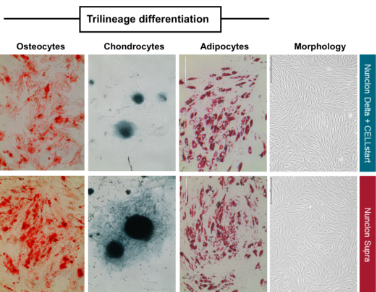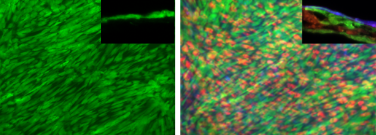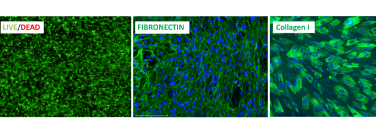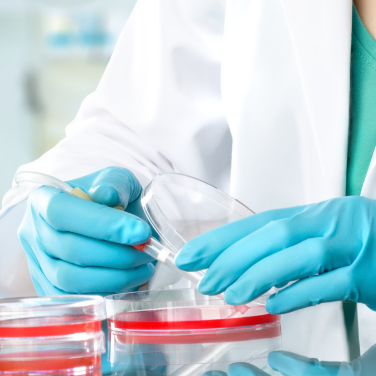Specialized Plastics for Cell Therapy Research
Cell therapy is the process of modifying and reintroducing a person’s own or external donor cells to restore the function of a diseased cell or eliminate cancer cells from the human body. The cells are administered by cell injection, blood transfusion, grafting, organ transplantation, or genetic modification.
Although cell therapy practices have existed for many years, a renewed interest in research in cell therapy—especially related to wound healing—occurred during World War II. More recently, chimeric antigen receptor (CAR) expressing immune cell therapy has shown promising results as a cancer treatment.
Stem Cells: Current Status and Challenges
Because of their capacity for self-renewal, multilineage differentiation, ease of isolation, and in vitro cell culture tolerance, mesenchymal stem cells (MSCs) are a popular choice for cell therapy and regenerative medicine. MSCs have been used in bone and cartilage repair, cardiovascular disease conditions, and to repair damaged musculoskeletal tissues.1, 2, 3 However, ongoing research is being performed to help increase the success rate of stem cell therapies by better understanding the reasons for rejection and the fate of therapeutic stem cells in the body.
To prepare the cells for injection, cell sheet grafting, or cell patch seeding, they may be cultured in vitro using fetal bovine serum (FBS) and other proteins. However, animal-sourced products can induce immune reactions in patients, so compatible xeno- and serum-free media have been developed. Since these media also lack attachment factors, MSC cultures require the addition of extracellular matrix (ECM) proteins, which may contain potentially immunogenic molecules.4 Alternatively, specialized surfaces can be used for growing stem cells under serum- and ECM coating-free conditions to support the formation of intact cell sheets.

Figure 1. Nunclon Supra surfaces support MSC attachment and differentiation potential to adipocytes (Oil Red O staining), chondrocytes (Alcian Blue staining), and osteocytes (Alizarin Red staining).
Nunclon Supra Surfaces
Thermo Fisher Scientific developed Nunclon™ Supra™ surfaces by exposing polystyrene to a proprietary energy source that produces a more hydrophilic surface than conventional tissue culture surface treatments. This increases cell attachment, eliminating the need to add an ECM or serum. This surface was tested by growing human MSCs derived from bone marrow, adipose tissue, and umbilical cord under serum- and coating-free conditions. Cells showed equivalent attachment and growth on uncoated Nunclon Supra surfaces when compared to a Nunclon™ Delta™ surface coated with the CELLstart™ ECM substrate. Additionally, MSCs grown on Nunclon Supra surfaces preserved their immuno-phenotypic profile, assessed by the positive expression of MSC-specific surface markers and negative expression hematopoietic stem cell markers. The MSCs also showed efficient trilineage differentiation to osteocytes, adipocytes, and chondrocytes (Figure 1). Taken together, MSCs can be successfully grown and differentiated on Nunclon Supra surfaces without using serum or ECM and therefore effectively used for cell therapy research.

Figure 2. Single layer (left) and stacked (right) cell sheets fabricated on Nunc UpCell surfaces. Individual cell monolayers were pre-stained with CellTracker dyes for better visualization. Inset: Cross sectional view of the respective cell sheets.
Nunc UpCell Surfaces
Cell sheet tissue engineering is a scaffold-free approach to regenerating damaged tissue cells, a technique introduced in 1990. Before that, structure collagen or hydrogel were used as scaffolds to create tissue patches. Nunc™ UpCell™ dishes are grafted with a temperature-responsive polymer (poly(N-isoproplyacrylamide or PIPAAm) that allows confluent cell monolayers to be harvested as intact sheets when the temperature is reduced from 37°C to below 32°C. This avoids the need for protease treatment, which preserves cell-cell junctions, cell surface proteins, and extracellular matrix in the sheet.
By using UpCell surfaces, 3D tissue can also be created by layering cell sheets. As shown in Figure 2, both single and stacked MSC cell sheets were fabricated using UpCell coated with vitronectin. The harvested sheets consisted of live cells (confirmed using Invitrogen™ LIVE/DEAD™ imaging) and retained expression of extracellular matrix proteins like fibronectin and collagen (Figure 3).

Figure 3. The cell sheets fabricated on Nunc UpCell surfaces were stained for live cell population and ECM proteins, fibronectin, and collagen I. Images were captured using the EVOS M7000 imaging system.
Cell therapy is expected to continue to make significant contributions to medicine in the coming years, many of them driven by ongoing research in these areas. The use of Nunclon Supra and UpCell surfaces to support stem cell growth and cell sheet generation should continue to support research on the next generation of MSC therapies. These tools are expected to enable scientists everywhere to more effectively culture stem cells and accelerate cell therapy research.
To learn more about Thermo Scientific Nunc specialty and core lab products or Thermo Scientific cell therapy research products, visit fishersci.com/thermocellculture.
You can also visit fishersci.com/gibco to find a range of products suitable for cell therapy research applications. Contact your Fisher Scientific sales representative for more details.
- Savkovic , V. et al. (2014). Mesenchymal Stem Cells in Cartilage Regeneration. Current Stem Cell Research & Therapy, Volume 9, Issue 6. https://www.eurekaselect.com/article/61317
- Bagno, L. et al. (2018, May 15). Mesenchymal Stem Cell-Based Therapy for Cardiovascular Disease: Progress and Challenges. Molecular Therapy. https://www.cell.com/molecular-therapy-family/molecular-therapy/fulltext/S1525-0016(18)30212-0
- Mahindran, E. et al. (2021, September 29). Mesenchymal Stem Cell Transplantation for the Treatment of Age-Related Musculoskeletal Frailty. International Journal of Molecular Sciences. https://www.mdpi.com/1422-0067/22/19/10542
- McQuitty, C. et al. (2020, November 11). Immunomodulatory Role of the Extracellular Matrix Within the Liver Disease Microenvironment. Frontiers in Immunology. https://www.frontiersin.org/articles/10.3389/fimmu.2020.574276/full

Content provided by:






